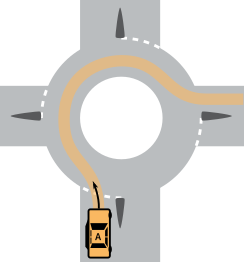Australian Road Rules: Indicating left when exiting a roundabout
Consider the situation in the following diagram:

Car A is approaching a roundabout and wishes to exit the roundabout at the third exit.
Question. What indicators should the driver use in this situation?
Answer. Indicate right when entering the intersection, continue indicating right until approaching the exit, then, if practicable, indicate left while exiting the intersection.
Australian Road Rule 113 (‘Giving a right change of direction signal when entering a roundabout’) says:
(1) This rule applies to a driver entering a roundabout if the driver is to leave the roundabout more than halfway around it.
(2) Before entering the roundabout, the driver must give a right change of direction signal for long enough to give sufficient warning to other drivers and pedestrians.
(3) The driver must continue to give the change of direction signal while the driver is driving in the roundabout, unless:
(a) the driver is changing marked lanes, or entering another line of traffic; or
(b) the driver’s vehicle is not fitted with direction indicator lights; or
(c) the driver is about to leave the roundabout.
This should be unsurprising. (In comparison, Australian Road Rule 112 provides that a left change of direction signal must be given while entering, in and exiting the roundabout, if leaving at the first exit, and the exit is less than halfway around the roundabout.)
What may, unfortunately, be surprising to many drivers, however, is that Australian Road Rule 118 (‘Giving a left change of direction signal when leaving a roundabout’) says:
(1) If practicable, a driver driving in a roundabout must give a left change of direction signal when leaving the roundabout.
A casual search of internet forums reveals many confused drivers believing that this is optional, or is not a road rule, or is, indeed, a silly thing to do. From personal experience, the vast majority of drivers do not indicate left when leaving roundabouts. The law, however, is clear that a left change of direction signal must be given when leaving a roundabout, ‘if practicable’.
When is it ‘practicable’?
Opinions seem to be divided on under what circumstances it is ‘practicable’ to give a left change of direction signal as described by Australian Road Rule 118.
The Royal Automotive Association of South Australia (RAA) appears to be of the opinion that the law expects a left change of direction signal in the situation depicted.
On the other hand, the VicRoads Drive Test criteria booklet states that:
signalling to leave a roundabout is not usually practicable at any but the largest roundabouts; for each roundabout on a test route, the VicRoads Customer Service Manager will determine whether a signal is required when leaving the roundabout (p. 9)
Presumably, this refers to the large multi-lane kind of roundabout found on main roads, rather than the small roundabouts common to suburban backroads.
The NSW Roads and Maritime Services Driving Test (Class C) Testing Officer's Manual, by comparison, has given up entirely on deciding what is and isn't practicable, saying:
When leaving a roundabout, a left change of direction signal, is only scored when the roundabout has more than one marked lane within the roundabout OR there is more than one lane on the exit of the roundabout that we are taking (the roundabout may only have single lanes within the roundabout, however if there is more than one lane on the exit we are taking, a signal is required).
Note: The road rules require an exit signal where practicable; however for testing consistency signals are scored in the above manner. (p. C27)
The Queensland Driving Examiner Assessment Procedures Manual makes no attempt at all to give guidance on the matter and simply says ‘Fails to signal left before exiting from a roundabout when legally required to do so (QRR 118).’ (p. 58)
In the end, though, the application of the law is for neither the RAA or VicRoads/RMS to decide, but a matter of law for a court to determine. In the absence of a clear consensus on the meaning of ‘practicable’, it is probably safest (and most helpful to fellow road users) to indicate left when leaving a roundabout.